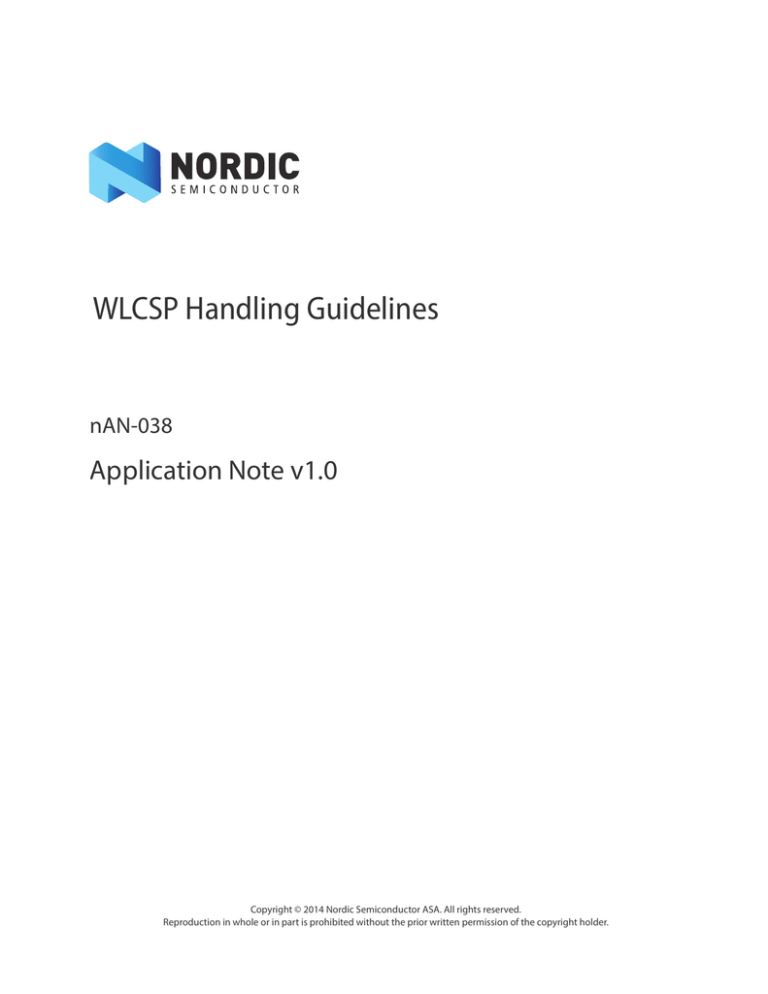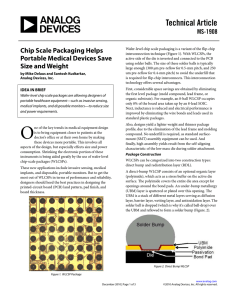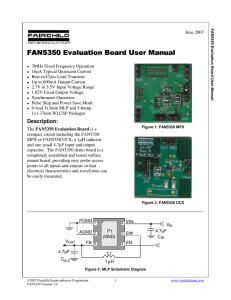
WLCSP Handling Guidelines
nAN-038
Application Note v1.0
Copyright © 2014 Nordic Semiconductor ASA. All rights reserved.
Reproduction in whole or in part is prohibited without the prior written permission of the copyright holder.
nAN-038 WLCSP Handling Guidelines v1.0
Table of contents
1
Introduction............................................................................................................................................... 3
2
2.1
2.2
Mounting recommendations ................................................................................................................. 5
WLCSP PCB layout guidelines ...................................................................................................................... 5
WLCSP SMT guidelines ................................................................................................................................... 7
3
Demounting recommendations ............................................................................................................ 8
4
Packing ....................................................................................................................................................... 9
5
References................................................................................................................................................ 10
Page 2
nAN-038 WLCSP Handling Guidelines v1.0
1
Introduction
WLCSP eliminates most of the first-level package materials found in traditional packages (lead frame or
substrate, die attach, wire bonds, and mold compound which results in better electrical connectivity and
conductivity). It also reduces the weight and three-dimensional space consumed by a lead frame-based
package or laminate-based CSP.
Figure 1 An example of WLCSP (nRF51-series)
Figure 2 WLCSP construction
Page 3
nAN-038 WLCSP Handling Guidelines v1.0
Figure 3 shows a WLCSP solder joint with the main geometric factors:
UBM pad, under bump via, and Printed Circuit Board (PCB) pad.
Figure 3 WLCSP solder joint
Page 4
nAN-038 WLCSP Handling Guidelines v1.0
2
Mounting recommendations
2.1
WLCSP PCB layout guidelines
2.1.1
Land pad pattern recommendations
PCB fabrication uses two types of land pad patterns during surface mount assembly, (see Figure 4).
• Non-solder mask defined (NSMD) - The metal pad on the PCB (to which a package pad or pin
will be attached) is smaller than the solder mask opening.
• Solder mask defined (SMD) - The solder mask opening is smaller than the metal part.
E^D
^D
;EŽŶͲ^ŽůĚĞƌDĂƐŬĞĨŝŶĞĚͿ
;^ŽůĚĞƌDĂƐŬĞĨŝŶĞĚͿ
^ŽůĚĞƌDĂƐŬ
ŽƉƉĞƌ^ŽůĚĞƌWĂĚ
W^ƵďƐƚƌĂƚĞ
Figure 4 NSMD and SMD land patterns
Page 5
^ŽůĚĞƌDĂƐŬ
nAN-038 WLCSP Handling Guidelines v1.0
NSMD and SMD each have their pros and cons, as shown in Table 1.
NSMD
PROS
SMD
CONS
PROS
CONS
Solder ball wets on the
sidewall of the exposed
copper pads thus
improving solder joint
reliability.
Solder mask opening
creates moats that allow
underfill deposits. This
irregular distribution of
underfill may introduce
stress on the solder mask
and copper trace.
Copper pads are stronger
since the solder mask
overlaps the copper thus
improving bond
adhesion between the
pad and the laminate.
Less space is formed inbetween pads when
routing signal traces.
Wider space is formed
when routing signal
traces due to small
copper area.
Potential underfill
voiding as the solder
mask opening provides
challenges on the
underfill's capillary
action.
Copper pads have a
bigger area thus
improving PCB to pad
chemistry during flexing
and excessive thermal
exposure.
Solder joint reliability
failures during thermal
cycle stress due to
absence of copper pad
sidewall.
Prior to pad lift due to
fully exposed copper pad
without solder mask
overlap.
Table 1 Pros and cons of NSMD and SMD
If NSMD pads are used, the NSMD pad diameter should be approximately 90% of the UBM diameter on the
package. If SMD pads are used on the motherboard, the SMD pad diameter should be equivalent to the
diameter of the UBM on the WLCSP package.
2.1.2
Pad recommendations for nRF51 series chips
When mounting WLCSP to rigid PCBs we recommend that NSMD pads are used. For flexible printed circuit
(FPC) board applications where underfill is required, Nordic Semiconductor recommends SMD pads. NSMD
is not recommended when the PCB applications require potential rework because NSMD is prone to pad lift
at multiple thermal exposure. However, in terms of solder joint reliability, NSMD produces a more reliable
solder joint during thermal cycle stress due to the available copper sidewall to which the solder can wet.
Nordic strongly suggests that you carry out a complete Design Of Experiments (DOE) and reliability testing
to determine the most suitable pattern for the given PCB application.
Here are some recommendations for the nRF51422-CEAA and nRF51822-CEAA WLCSP packages:
Description
Value
UBM pad size
155 μm
NSMD
CSP UBM Pad diameter x 0.9
SMD
Equal to CSP UBM Pad diameter
Table 2 Pad recommendations
Page 6
nAN-038 WLCSP Handling Guidelines v1.0
2.2
WLCSP SMT guidelines
WLCSP board assembly starts with solder paste screen-printing on the board prior to component pick and
place. Consider the following steps for all WLCSP applications:
• Stencil design guidelines: The stencil design guidelines outlined in the IPC-7525 should be
followed for all assemblies.
• Solder paste: A no-clean solder paste with a particle size no larger than 40 μm (Type 3) is
recommended.
• Package pick-up and placement:
• Z-height distance between the WLCSP and the pick-up tool should be set to zero or
with minimal gap. The vacuum lifts out the package from the pocket of the carrier
tape.
• Similarly, Z-height during placement should be set to zero or with a minimum gap
height to avoid overdrive during board placement.
• Reflow: All Nordic Semiconductor WLCSP are Pb-Free and are qualified at 260 °C reflow with
MSL1. Typical temperature profiles for the lead-free (Sn-Ag-Cu or Sn-Ag) solder and the
corresponding critical reflow parameters are shown in Figure 5 and Table 3.
Figure 5 Recommended reflow profile for Sn-Ag-Cu paste
Process step
Lead-Free solder
Ramp rate
3 °C/second
Pre-heat
150 °C to 180 °C, 60 to 180 seconds
Time above liquidus, 220 °C
30 to 90 seconds
Peak temperature
255 °C ±5 °C
Time within 5 °C of peak temperature
10 to 20 seconds
Ramp down rate
6 °C/second maximum
Table 3 Recommended reflow parameters for Sn-Ag-Cu paste
• Underfill: Optional
• SMT Rework: It's not recommended to re-solder demounted WLCSP. For demounting see
Chapter 3 “Demounting recommendations” on page 8.
Page 7
nAN-038 WLCSP Handling Guidelines v1.0
3
Demounting recommendations
Careful handling of WLCSP devices must be ensured in case devices are sent to Nordic Semiconductor for
analysis. WLCSP devices are very vulnerable and easily damaged. To proceed with the analysis, good
physical condition is a requirement.
Chipouts prevent further electrical analysis on the device as it covers the real failure. Meaning, chipouts
introduced during the transport might mask the original problem and make further analysis impossible or
can lead to a wrong conclusion.
You must ensure that the devices are handled carefully to allow analysis to proceed. Recommended
handling and shipping conditions can be found in Chapter 4 “Packing” on page 9.
The key factor for a successful demounting (device removal from PCB) is that the WLCSP device must be
lifted from the board in a vertical direction. Use a BGA repair station to ensure the device is lifted in a vertical
direction.
Note: When the device is not lifted vertically, the solder distributes throughout the CSP randomly,
making short circuits between the pins. This makes the sample preparation process longer.
Some chipouts can also be covered by solder and will only be revealed after cleaning.
When necessary, other components are needed to be removed to allow the head of the vacuum pen (or
other handling materials) to reach the position of the WLCSP device.
To pick up the WLCSP device, it is recommended to use ESD safe plastic tweezers or an ESD safe vacuum
pick-up pen. It is not recommended to use ceramic or metal tweezers during demounting due to the
tendencies in damaging the device.
Figure 6 Vacuum pen (left) and plastic tweezers (right)
Before attempting any rework ensure that the assembly is moisture-free. This is to prevent moisture damage
to the board or other components during rework. Under-board pre-heating is required at 100 °C to 125 °C
for eutectic solder and 150 °C to 170 °C for Pb-free solder.
In case underfill is used, removable underfills are available for chip mount and CSP assemblies.
Concentrated acids plus heat is applied to underfilled units in removing underfill. Another method is to use
heat and light abrasion. After this, the CSP is then pulled off during heating. We recommend re-workable
underfill.
Page 8
nAN-038 WLCSP Handling Guidelines v1.0
4
Packing
Products must be packaged carefully. Each WLCSP device must be in its own anti-static plastic bag, which is
properly marked to recognize the devices. The bags must be packed so that damage is impossible during
transportation.
Note: If multiple WLCSPs are packed in the same bag damage will occur, so this is not recommended.
Placing of WLCSP devices on masking tapes or any other adhesive tape is not allowed. This will make the
device removal difficult and prone to loss or damage and will also result in damage from ESD.
For temporary storage or for shipment of devices to Nordic, it is recommended to use ESD safe boxes or
trays or to put each WLCSP device into one ESD safe bag to avoid them coming into contact with each other.
An alternative and cost effective way to pack devices is to re-use the original carrier tape when shipping
back samples for analysis to Nordic. See Figure 7.
Figure 7 Re-use of original carrier tape as an alternative to chip trays
Below are important reminders:
1. Carefully place the WLCSP device inside the carrier pocket.
2. Use the transparent carrier cover to conceal the device.
3. DO NOT USE STICKY TAPE to cover the device as this will make the device removal difficult and
prone to loss or damage.
4. Use an ESD safe tape to fully seal the device inside the carrier.
5. Properly identify the samples: Place a sticker to indicate it’s device number.
6. Place the carrier inside an ESD safe plastic bag and place this inside a carton box with bubble wrap
as additional protection.
Page 9
nAN-038 WLCSP Handling Guidelines v1.0
5
References
• Deca Technologies WLCSP Assembly Guidelines.
Page 10
nAN-038 WLCSP Handling Guidelines v1.0
Liability disclaimer
Nordic Semiconductor ASA reserves the right to make changes without further notice to the product to
improve reliability, function or design. Nordic Semiconductor ASA does not assume any liability arising out
of the application or use of any product or circuits described herein.
Life support applications
Nordic Semiconductor’s products are not designed for use in life support appliances, devices, or systems
where malfunction of these products can reasonably be expected to result in personal injury. Nordic
Semiconductor ASA customers using or selling these products for use in such applications do so at their
own risk and agree to fully indemnify Nordic Semiconductor ASA for any damages resulting from such
improper use or sale.
Contact details
For your nearest distributor, please visit http://www.nordicsemi.com.
Information regarding product updates, downloads, and technical support can be accessed through your
My Page account on our homepage.
Main office: Otto Nielsens veg 12
7052 Trondheim
Norway
Mailing address: Nordic Semiconductor
P.O. Box 2336
7004 Trondheim
Norway
Phone: +47 72 89 89 00
Fax: +47 72 89 89 89
Revision History
Date
Version
Description
May 2014
1.0
First release
Page 11



